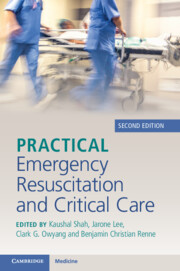Book contents
- Practical Emergency Resuscitation and Critical Care
- Practical Emergency Resuscitation and Critical Care
- Copyright page
- Contents
- Contributors
- Preface
- Section 1 General Critical Care
- Section 2 Infectious Disease Emergencies
- Section 3 Neurological Emergencies
- Section 4 Cardiovascular Emergencies
- 16 Post-Cardiac Arrest Care
- 17 Acute Coronary Syndrome
- 18 Acute Decompensated Heart Failure
- 19 Aortic Dissection
- 20 Hypertensive Emergencies
- 21 Valvular Diseases
- Section 5 Respiratory Emergencies
- Section 6 Gastrointestinal Emergencies
- Section 7 Renal Emergencies
- Section 8 Hematology–Oncology Emergencies
- Section 9 Endocrine Emergencies
- Section 10 Environmental Emergencies
- Section 11 Trauma
- Section 12 End of Life
- Index
- References
19 - Aortic Dissection
from Section 4 - Cardiovascular Emergencies
Published online by Cambridge University Press: 02 November 2023
- Practical Emergency Resuscitation and Critical Care
- Practical Emergency Resuscitation and Critical Care
- Copyright page
- Contents
- Contributors
- Preface
- Section 1 General Critical Care
- Section 2 Infectious Disease Emergencies
- Section 3 Neurological Emergencies
- Section 4 Cardiovascular Emergencies
- 16 Post-Cardiac Arrest Care
- 17 Acute Coronary Syndrome
- 18 Acute Decompensated Heart Failure
- 19 Aortic Dissection
- 20 Hypertensive Emergencies
- 21 Valvular Diseases
- Section 5 Respiratory Emergencies
- Section 6 Gastrointestinal Emergencies
- Section 7 Renal Emergencies
- Section 8 Hematology–Oncology Emergencies
- Section 9 Endocrine Emergencies
- Section 10 Environmental Emergencies
- Section 11 Trauma
- Section 12 End of Life
- Index
- References
Summary
Aortic dissection represents the most frequent aortic catastrophe with approximately 10,000 cases annually in the United States. Dissection occurs with a primary tear of the intimal layer of the aorta and then subsequent infiltration into the media layer, creating a false lumen that may extend the entire length of the aorta.
Propagation of the false lumen may result in obstruction of vascular branches of the aorta, leading to end organ hypoperfusion of the brain, heart, kidneys, spine or extremities.
The location of injury (i.e., ascending versus descending aorta) predicts mortality and guides management decisions.
- Type
- Chapter
- Information
- Practical Emergency Resuscitation and Critical Care , pp. 169 - 176Publisher: Cambridge University PressPrint publication year: 2023

